Indexed In
- Open J Gate
- Genamics JournalSeek
- Academic Keys
- JournalTOCs
- China National Knowledge Infrastructure (CNKI)
- Ulrich's Periodicals Directory
- RefSeek
- Hamdard University
- EBSCO A-Z
- Directory of Abstract Indexing for Journals
- OCLC- WorldCat
- Publons
- Geneva Foundation for Medical Education and Research
- Euro Pub
- Google Scholar
Useful Links
Share This Page
Journal Flyer

Open Access Journals
- Agri and Aquaculture
- Biochemistry
- Bioinformatics & Systems Biology
- Business & Management
- Chemistry
- Clinical Sciences
- Engineering
- Food & Nutrition
- General Science
- Genetics & Molecular Biology
- Immunology & Microbiology
- Medical Sciences
- Neuroscience & Psychology
- Nursing & Health Care
- Pharmaceutical Sciences
Opinion Article - (2023) Volume 13, Issue 3
The Revolutionary Potential of Stem Cell Banking
Phili Lopez*Received: 29-Apr-2023, Manuscript No. JSCRT-23-21569; Editor assigned: 02-May-2023, Pre QC No. JSCRT-23-21569(PQ); Reviewed: 17-May-2023, QC No. JSCRT-23-21569; Revised: 24-May-2023, Manuscript No. JSCRT-23-21569(R); Published: 01-Jun-2023, DOI: 10.35248/2157-7633.23.13.596
Description
Stem cells, with their unique ability to self-renew and differentiate into various specialized cell types, have captivated the attention of scientists, clinicians, and the general public alike. Stem cell banking, also known as stem cell preservation or cryopreservation, involves the collection, processing, and storage of these cells for future medical use. This practice has gained considerable traction in recent years due to its potential applications in treating a range of diseases and injuries. This is delves into the concept of stem cell banking, its historical development, and the scientific principles behind it. Stem cells can be derived from various sources, including embryos, umbilical cord blood, and adult tissues such as bone marrow and adipose tissue. Each source has its own advantages and limitations in terms of availability, potency, and ethical considerations. Umbilical cord blood, in particular, has emerged as a rich source of hematopoietic stem cells, which are responsible for generating new blood cells. Cord blood banking involves the collection of blood from the umbilical cord immediately after birth, followed by processing and cryopreservation of the stem cells for long-term storage.
Potential applications and advancements
Stem cell banking holds tremendous potential for advancements in regenerative medicine, disease treatment, and personalized healthcare. The stored stem cells can be utilized in various ways, such as for autologous transplantation, allogeneic transplantation, and in the development of new cell-based therapies. Autologous transplantation involves using an individual's own stem cells for their own treatment, which eliminates the risk of rejection. Allogeneic transplantation, on the other hand, involves using stem cells from a matched donor for treating patients with diseases such as leukemia and lymphoma. Stem cell banking also opens up possibilities for the development of personalized medicine. With the advent of induced Pluripotent Stem Cells (iPSCs), which can be generated from adult cells, it becomes feasible to create patient-specific stem cell lines for disease modeling, drug screening, and potential transplantation. This approach has the potential to revolutionize the treatment of genetic disorders, neurodegenerative diseases, and other conditions with a strong genetic component.
Stem cell research and banking have been subjects of ethical debates due to the use of Embryonic Stem Cells (ESCs) derived from human embryos. The ethical concerns surrounding ESCs have prompted researchers to explore alternative sources, such as umbilical cord blood and adult stem cells, which do not raise the same ethical dilemmas umbilical cord blood banking, in particular, is widely accepted as it poses no harm to the donor or the newborn and offers a readily available source of stem cells. While stem cell banking holds immense promise, several challenges need to be addressed for its widespread implementation. These challenges include the high cost of banking, limited awareness among the general public, regulatory frameworks, and standardization of procedures for collection, processing, and storage. Additionally, advances in emerging technologies, such as gene editing and tissue engineering, will further shape the future of stem cell banking and its applications. Stem cell banking represents a paradigm shift in medical advancements, offering a unique opportunity to revolutionize healthcare through regenerative medicine and personalized treatments. The potential applications of stem cells are vast and encompass a wide range of diseases and injuries. However, the field also faces significant challenges that must be addressed to harness its full potential. Continued research, ethical considerations, and improved accessibility are key to unlocking the transformative power of stem cell banking. By exploring and embracing this field, this can pave the way for a future where debilitating diseases are treated with ease and personalized medicine becomes a reality.
Citation: Lopez P (2023) The Revolutionary Potential of Stem Cell Banking. J Stem Cell Res Ther. 13:596.
Copyright: © 2023 Lopez P. This is an open-access article distributed under the terms of the Creative Commons Attribution License, which permits unrestricted use, distribution, and reproduction in any medium, provided the original author and source are credited.

